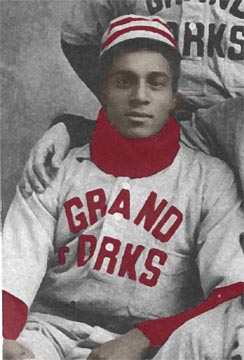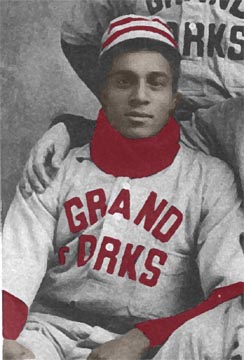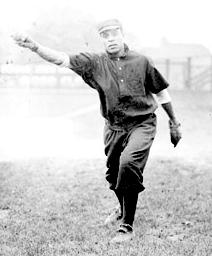Born: September 13, 1877 in Detroit
Died: December 15, 1946 in Chicago.
Ht:5'-10", Wt: 170
Batted left and threw left
Position: pitcher
Years: 1899-1923
Teams: St. Paul (MN), St. Cloud (MN), Grand Forks, (ND), Augusta (GA), Chicago Union Giants, Cuban X-Giants, Philadelphia Giants, Brooklyn Royal Giants, Chicago Lelands, Quaker Giants, St. Paul Colored Gophers, Pittsburgh Keystones, Chicago Giants, Chicago American Giants, St. Louis Giants, Mohawk Giants of Schenectady, NY, New York Lincolns, Milwaukee Giants, Cuba.
Walter Ball was one of black baseball's very first great pitchers, combining pinpoint control with the occasional spitter to make up for a lack of overwhelming speed.
Ball was born in Detroit, Michigan, but grew up in St. Paul, Minnesota, and spent a decade playing for predominantly white teams.
According to Jim Karn in "Swinging for the Fences," Ball's first pitching decision published in a paper was a victory against a team called the Tigers in 1896 by the score of 26-25.
Ball plied his trade on the sandlots of the Capital City with the "Young Cyclones," a top amateur team. In 1900, Ball became a professional when he signed with the Grand Forks semipro team. Ball often pitched in games in which "purses" of less than $20 were offered to the winner.
In 1902, Ball returned to Minnesota and pitched St. Cloud to a semipro championship.
Over the next several years, Ball played for many teams in the Midwest. During that era, most teams carried only a couple pitchers, so Ball was expected to pitch often, and rarely was given the luxury of a relief pitcher if he got into trouble. Ball usually won more than 20 games a season, struck out more than a batter an inning, and had an ERA of less than two runs.
Ball was known as a classy man and sharp dresser, and was usually treated well, to his face, in the smaller towns in which he played in his early career. However, many Midwest towns, despite loving the way Ball pitched, didn't like having a black man representing their town, and Ball was released several times after great seasons on the field.
Ball, besides being a first-class pitcher, was industrious. While pitching in North Dakota, Ball picked up extra money as a train porter and while pitching for St. Cloud (MN), Ball rented cushions to fans at the ball park at a nickel a piece.
In 1903, Ball jumped to the big time in black baseball, signing with the Chicago Union Giants, the first all-black team he had played for, and in 1904, Ball jumped to the Cuban X-Giants, and beat the Brooklyn Dodgers during the year, his first victory over a Big League club. His teammates on the X-Giants included Homerun Johnson and Dan McClellan.
After a few more years in Midwest black baseball, Ball returned to St. Paul to start the St. Paul Colored Gophers.
Continuing his nomadic days, Ball eventually returned to Chicago again and pitched with the Chicago Giants and Chicago American Giants, teaming with such stars as Rube Foster, John Beckwith and Steel Arm Taylor.
By the time the first Negro National League was formed in 1920, Ball was nearing the end of his career, though he reportedly pitched a few more seasons.
Ball continued to stay in baseball after his playing days were over, coaching, organizing, etc., and at the 1937 East-West All-Star Game in Chicago, Ball was honored on the field.
Ball died in December of '46, but not before Jackie Robinson had played an incredible season with the Montreal Royals. Ball, as well as the rest of the baseball world, knew that the color line in the Majors was on its last legs.
Ball, a certain Major League star pitcher had he been born 40 years later, is buried in Lincoln Cemetery (Cook County, IL), about 60 feet, six inches from Rube Foster's grave.(pitchblackbaseball.com)
Born: September 13, 1877 in Detroit
Died: December 15, 1946 in Chicago.
Ht:5'-10", Wt: 170
Batted left and threw left
Position: pitcher
Years: 1899-1923
Teams: St. Paul (MN), St. Cloud (MN), Grand Forks, (ND), Augusta (GA), Chicago Union Giants, Cuban X-Giants, Philadelphia Giants, Brooklyn Royal Giants, Chicago Lelands, Quaker Giants, St. Paul Colored Gophers, Pittsburgh Keystones, Chicago Giants, Chicago American Giants, St. Louis Giants, Mohawk Giants of Schenectady, NY, New York Lincolns, Milwaukee Giants, Cuba.
Walter Ball was one of black baseball's very first great pitchers, combining pinpoint control with the occasional spitter to make up for a lack of overwhelming speed.
Ball was born in Detroit, Michigan, but grew up in St. Paul, Minnesota, and spent a decade playing for predominantly white teams.
According to Jim Karn in "Swinging for the Fences," Ball's first pitching decision published in a paper was a victory against a team called the Tigers in 1896 by the score of 26-25.
Ball plied his trade on the sandlots of the Capital City with the "Young Cyclones," a top amateur team. In 1900, Ball became a professional when he signed with the Grand Forks semipro team. Ball often pitched in games in which "purses" of less than $20 were offered to the winner.
In 1902, Ball returned to Minnesota and pitched St. Cloud to a semipro championship.
Over the next several years, Ball played for many teams in the Midwest. During that era, most teams carried only a couple pitchers, so Ball was expected to pitch often, and rarely was given the luxury of a relief pitcher if he got into trouble. Ball usually won more than 20 games a season, struck out more than a batter an inning, and had an ERA of less than two runs.
Ball was known as a classy man and sharp dresser, and was usually treated well, to his face, in the smaller towns in which he played in his early career. However, many Midwest towns, despite loving the way Ball pitched, didn't like having a black man representing their town, and Ball was released several times after great seasons on the field.
Ball, besides being a first-class pitcher, was industrious. While pitching in North Dakota, Ball picked up extra money as a train porter and while pitching for St. Cloud (MN), Ball rented cushions to fans at the ball park at a nickel a piece.
In 1903, Ball jumped to the big time in black baseball, signing with the Chicago Union Giants, the first all-black team he had played for, and in 1904, Ball jumped to the Cuban X-Giants, and beat the Brooklyn Dodgers during the year, his first victory over a Big League club. His teammates on the X-Giants included Homerun Johnson and Dan McClellan.
After a few more years in Midwest black baseball, Ball returned to St. Paul to start the St. Paul Colored Gophers.
Continuing his nomadic days, Ball eventually returned to Chicago again and pitched with the Chicago Giants and Chicago American Giants, teaming with such stars as Rube Foster, John Beckwith and Steel Arm Taylor.
By the time the first Negro National League was formed in 1920, Ball was nearing the end of his career, though he reportedly pitched a few more seasons.
Ball continued to stay in baseball after his playing days were over, coaching, organizing, etc., and at the 1937 East-West All-Star Game in Chicago, Ball was honored on the field.
Ball died in December of '46, but not before Jackie Robinson had played an incredible season with the Montreal Royals. Ball, as well as the rest of the baseball world, knew that the color line in the Majors was on its last legs.
Ball, a certain Major League star pitcher had he been born 40 years later, is buried in Lincoln Cemetery (Cook County, IL), about 60 feet, six inches from Rube Foster's grave.(pitchblackbaseball.com)
Sponsored by Ancestry
Advertisement
Advertisement




